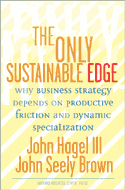The Only Sustainable Edge: Why Business Strategy Depends on Productive Friction and Dynamic Specialization
By John Hagel III and John Seely Brown
Harvard Business School Press,
March 2005 192 pages, $25
The problem with creating strategy is you constantly have to update it, depending on what happens in the marketplace. For example, no sooner do you move your manufacturing offshore to gain a pricing edge then your rivals do too, and you’re back to square one in terms of competitive advantage.
The authors—Hagel, a former McKinsey & Co. consultant, and Brown, Xerox Corp.’s former chief scientist and the former head of the Xerox Palo Alto Research Center—understand that. So instead of offering incremental changes to the way you do business, what they suggest here is nothing less than a radical three-step model for transforming what you do for a living and how you do it.
Step one—become more specialized—builds off what you are probably doing now. But Hagel and Brown take the basic concept of “do what you do best, and outsource the rest” to new extremes. They want you to become so focused that you can respond almost instantly to any change in the market.
For example—and the example is ours, since they don’t provide many—if you make disk drives but your real values added is in the optical components of the drives, then you should focus on the optics. By specializing to this degree, you become so attuned to what is going on in the marketplace that you can respond almost instantly with either a new product or price.
If you are going to become this focused, then obviously you will need to forge strong relationships with companies that will do everything for you that you can’t. But the second step involves not only looking for partners to compensate for your weaknesses; you want to work with other firms that can complement your core strengths with theirs, allowing you to leverage those strengths.
So, in our mythical case, you would be looking to partner with a company that could make the rest of the disk drive, with the hope that by combining forces you synergistically can come up with innovative improvements. Your strengths rub up against theirs—thus the term “productive friction” in the subtitle—and, the authors say, better products and processes result.
Step three in the transformation process? You want to tap into a global network of customers so you can get the absolute most from your sales efforts. To continue our example, if you do it right, you become the primary supplier of disk-drive optical components worldwide.
The net result, as the authors put it in language that is, unfortunately, all too typical: “[Your] institutional ability to shape and support continuing waves of operational innovation becomes the real source of sustainable competitive advantage because it creates distinctive organizational capabilities that cannot be copied.”
Of course, it is impossible to tell if the strategy that Hagel and Brown lay out is the ultimate way to outflank your competition. What is clear is that taking incremental steps is exhausting and only temporarily effective at best. Thinking long term, while still managing to get the product out the door every day, is the only way to succeed.
Paul B. Brown is the author of numerous business books.
